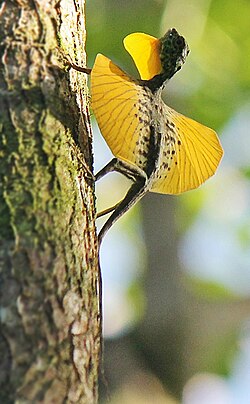| Draco | |
|---|---|
 | |
| D. taeniopterus in mid-glide, on Bulon Island, Thailand | |
 | |
| Male D. spilonotus extending the dewlap (throat flap) and patagia ("wings") in Sulawesi, Indonesia | |
| Scientific classification | |
| Kingdom: | Animalia |
| Phylum: | Chordata |
| Class: | Reptilia |
| Order: | Squamata |
| Suborder: | Iguania |
| Family: | Agamidae |
| Subfamily: | Draconinae |
| Genus: | Draco Linnaeus, 1758 |
| Species | |
41 species (see text) | |
 | |
Draco is a genus of agamid lizards [1] that are also known as flying lizards, flying dragons or gliding lizards. These lizards are capable of gliding flight via membranes that may be extended to create wings (patagia), formed by a support structure from an enlarged set of ribs. [2] They are arboreal insectivores.
Contents
- History of discovery
- Distribution and habitats
- Overall description
- Gliding
- Life history
- Phylogenetics
- Species
- Similar prehistoric reptiles
- See also
- References
- Further reading
While not capable of powered flight they often obtain lift in the course of their gliding flights. Glides as long as 60 m (200 ft) have been recorded, over which the animal loses only 10 m (33 ft) in height which makes for a glide ratio of 6:1. This is done by a lizard of only around 20 cm (7.9 in) in total length, tail included. [3] They are found across Southeast Asia and Southern India and are fairly common in forests, areca gardens, teak plantations and shrub jungle.






